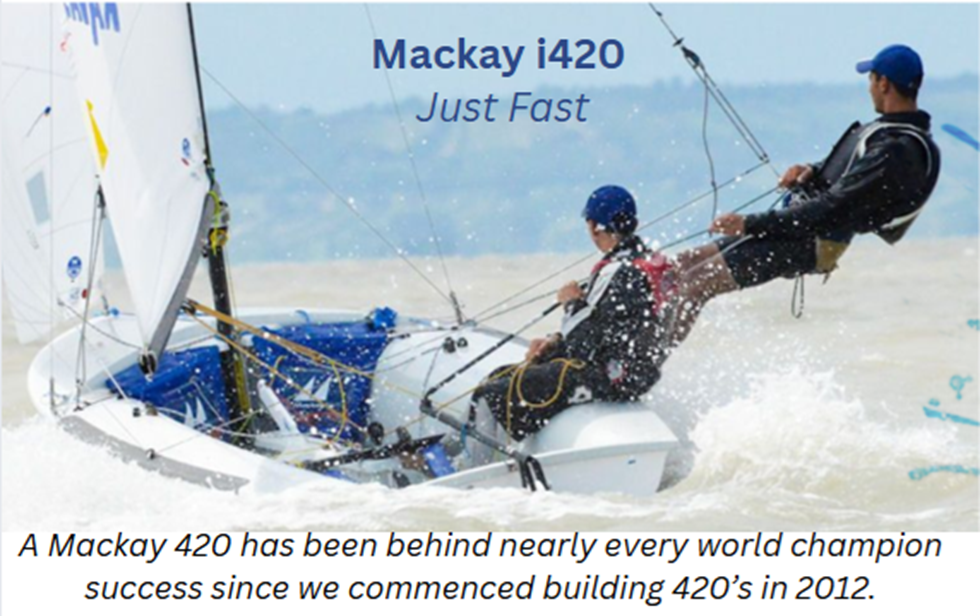By Airwaves writer Zach Brown
It’s an exciting time to be involved in high school and college sailing. Even in the face of an economic downturn, new programs are popping up all over the country. Teams are receiving more support from their Universities in the form of money or varsity status. And the governing body of ICSA has been progressive, introducing new changes over the last years. LaserPerformance is adding to the improvement of college sailing with the introduction of the Collegiate 420.
Over the last ten years there has been plenty of discussion about the creation of a modern collegiate boat. The debate has always been between performance and durability with the price tag serving as the moderator. Modern boat building technology combined with an increased focus on advancing collegiate sailing has given LaserPerformance the ability to improve the Club 420’s speed and strength without raising the cost.
History Lesson
Born in France in 1959, the 420 first gained traction as a development boat for the 470. It grew in popularity over the 60’s and made its way to the shores of the US. Yale was the first University to create a sailing club, and also the first to order a modified version of the 420 in 1977 from Vanguard. Yale’s Club 420 was thicker and stronger, preventing cracking of its rails when it bumped into a dock or another boat.
The evolution of the 420 to Club 420 was motivated by the need to lower costs and minimize boat repairs. Although fixing boats taught students valuable lessons about handiwork, boat care, and responsibility, the materials and equipment were expensive. The tradeoff between spending time on boat repair or time on the water drove college programs to request more durable boats. Breakdowns and byes were a common issue that plagued college sailing until the Club 420 evolved into the sturdy but heavy pigs sailed today.
Stronger, Better, Faster
Led by St. Mary’s coach Adam Werblow, LaserPerformance set out to design a new college sailing dinghy. Werblow started with the key questions: “How can we make the 420 lighter, more exciting, and more durable with modern boat building techniques? How can we make the boat look fun?” The LaserPerformance team had to work within some narrow parameters: maintain price, maintain boat size to fit existing college infrastructure such as docks and dollies, maintain equipment to make old and new parts interchangeable, honor the college system of ease and simplicity, decrease weight, improve performance, and increase durability. To accomplish this task they brought in some outside help from a naval architect who was also a college sailing star.
Laser Performance put considerable time, effort, and resources towards the project and redesigned the 420 to advance the sport of college sailing. The end result was the Collegiate 420, which features a core layer in the hull and deck that makes the boat twenty pounds lighter and significantly stronger with a closed forward bulkhead. Other small changes include inboard jib leads, an integrated bow bumper, and new fittings. The boat is a platform for change and the sky is the limit. More modified equipment such as masts, sails, and foils are in test phases but won’t be implemented just yet. Werblow smartly stated, “Change for the sake of change is not helpful.” LaserPerformance wants the progression of performance to be eased into high school and college sailing to avoid introducing an oddball fleet.
Get Ready for the Collegiate 420
The Collegiate 420 prototype is coming to a sailing venue near you this fall. For college sailors, there won’t be a huge time gap between testing the boat this fall and racing it for the first time in a regatta. It would be wise to get some boat time in the prototype because the Collegiate 420 will be the feature boat at St. Mary’s College for the 2014 ICSA Coed College Sailing Nationals. Look for another article in the near future that will unveil the Collegiate 420 specs, photos, and more at www.sail1design.com.


[…] month, Airwaves writer Zach Brown published an article on “Meet The New Collegiate 420.” This article presented information on LaserPerformance’s new 420 design made specifically for […]